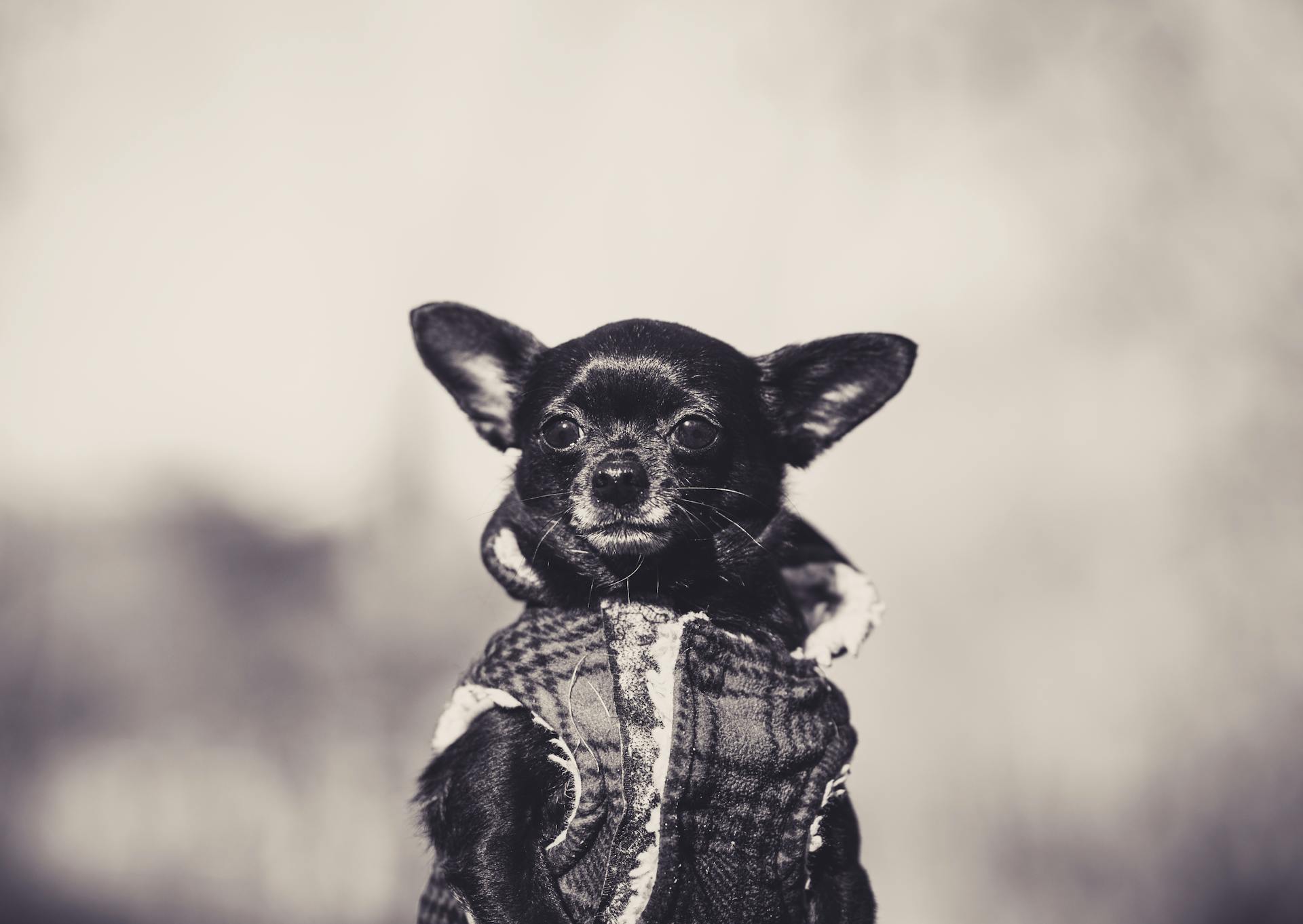
Chihuahuas have been around for thousands of years, with evidence suggesting they originated in Mexico.
Their ancestors, the Techichi, were a type of dog that dates back to around 1000 BC.
The Techichi was a small, loyal dog that was often buried with its owners in ancient Mexico.
These early dogs were highly valued for their companionship and were often given as gifts to royalty.
The Ancestral Roots
The Chihuahua's lineage is shrouded in mystery, but historians believe their ancestors were present in the Fertile Crescent over 3000 years ago. However, the connection to the ancient Techichi dogs of the Toltec civilization in Mexico provides the most apparent lineage to the modern Chihuahua.
The Techichi, revered in Toltec society, were small, sturdy, and silent dogs, characteristics that are evident in today's Chihuahuas. These dogs were not only companions but also held spiritual significance, believed to guide the soul to the underworld. As the Toltec civilization gave way to the Aztecs, the Techichi's significance was absorbed and magnified within Aztec culture.
Discover more: Mini Dachshund Mix with Chihuahua
The Techichi were believed to possess mystical powers and were often buried with their deceased owners to guide the afterlife. Their association with the god Xolotl, the deity of lightning and death, further solidified their importance in Aztec society.
Here's a brief overview of the Chihuahua's ancestral roots:
- Fertile Crescent: 3000+ years ago
- Toltec civilization: Ancient Techichi dogs
- Aztec culture: Absorbed and magnified Techichi significance
- Spiritual significance: Guided souls to the underworld
- Association with Xolotl: Deity of lightning and death
The arrival of the Spanish conquest in the 16th century disrupted traditional breeding practices and the cultural significance of the Techichi within Aztec society. However, the ancestors of the modern Chihuahua managed to survive, largely due to their adaptability and the remote regions of Mexico where they could find refuge.
History of the Breed
The Chihuahua breed originates from Mexico, specifically from the region that is now known as the Mexican state of Chihuahua.
Historians and canine experts believe that Chihuahuas are descendants of the Techichi, a small dog breed that was integral to Toltec civilization around the 9th century. The Techichi were highly valued by the Toltecs and later by the Aztecs for both companionship and religious significance.
The Chihuahua's distinctive features and size can be traced back to these ancestral roots, although the breed as known today has also been influenced by European dogs brought by Spanish conquerors.
Officially discovered in the mid-19th century, the Chihuahua is believed to be a direct descendant of the Techichi, a small desert canine that dates back to Mayan times. These pre-Columbian dogs resembled Chihuahuas in both size and shape and are believed to have been domesticated by the ancient Toltecs civilization.
Studies conducted by the Institute of Technology in Stockholm confirm that roughly 70% of modern Chihuahua's DNA originates from the ancient South American Techichi.
See what others are reading: What Kinds of Chihuahuas Are There
1800-2000: The Breed and AKC
The modern-day Chihuahua was discovered in Central and South America in the mid to late-1800s. This tiny dog breed originated in Chihuahua, Mexico, and was bred and sold to American tourists.
Mexican merchants played a key role in introducing the Chihuahua to the US, where Americans kept them as pets. The breed quickly gained popularity among Americans.
The American Kennel Club (AKC) recognized the Chihuahua breed in 1904. This marked a significant milestone in the breed's history.
The first Chihuahua registered with the AKC was a dog named Bleppie, which happened in 1908.
How Did It Get Its Name?

The Chihuahua breed got its name from the Mexican state of Chihuahua, where the earliest specimens were discovered by Americans in the mid-19th century.
This geographical marker signifies the breed's deep Mexican roots and heritage, reflecting its historical and cultural significance in Mexico. The name was chosen to highlight the region's role in the development and preservation of the breed.
The discovery of these small dogs in Chihuahua piqued the interest of visitors, especially from the United States, who were fascinated by their size and temperament. They began to export them back to their home country, where the breed's popularity quickly grew.
The naming of the breed after the state of Chihuahua serves as a nod to its storied past and origins, linking the modern-day dog to its ancestral homeland.
If this caught your attention, see: Perritos Chihuahuas
Association with Royalty and Nobility
The Chihuahua's association with royalty and nobility is a fascinating aspect of its history. This prestige can be traced back to its ancient origins in Mesoamerica, where they were kept by the upper classes and seen as symbols of status.
In ancient Mesoamerican cultures, the Chihuahua served as a symbol of status among the upper classes. Its small size and unique characteristics made it an ideal companion for the elite.
The Chihuahua's popularity among the Mexican nobility continued into the colonial period, where European visitors to Mexico noted its widespread presence among the nobility. This further solidified its reputation as a breed associated with high status.
The Chihuahua's elegance, small size, and unique personality made it a favorite among the social elite and celebrities in modern times. Its appearance in popular media and association with high-profile individuals have perpetuated its image as a pet of the wealthy and fashionable.
On a similar theme: Why Are Chihuahuas so Small
The Significance of Its Size in History
The Chihuahua's small size has been a defining trait throughout its history, making it unique among dog breeds. In ancient Mesoamerican cultures, their diminutive stature allowed them to be kept easily within households, where they served both as companions and spiritual symbols.

Their small size made them ideal for fulfilling their role in religious practices and beliefs, including burial rituals. This physical characteristic was a significant aspect of their appeal and functionality as a pet throughout history.
The Chihuahua's small size contributed to its popularity as a companion animal, especially suited for urban living and for owners who prefer smaller pets. It's no wonder they've become a favorite among city dwellers and those with smaller living spaces.
Studies confirm that the Chihuahua's small size has remained relatively unchanged over time, with approximately 70% of modern Chihuahua's DNA originating from the ancient South American Techichi.
Challenges Faced by the Breed
The Chihuahua faced near extinction after the Spanish conquest of Mexico, which led to a drastic reduction in the native dog population due to disease and environmental changes.
This period of decline was a significant challenge for the breed, threatening its very existence.
The establishment of breed standards by kennel clubs helped to mitigate the issues caused by crossbreeding and a lack of breed standards.
Dedicated breeding programs also played a crucial role in preserving the Chihuahua's distinct physical and temperamental traits.
These efforts have allowed the Chihuahua to thrive and maintain its status as one of the most recognizable and beloved dog breeds in the world.
Become Mainstream
The Chihuahua's rise to fame is a fascinating story. In the late 1800s, this breed began to pop up all around Central and South America, with the main point of origin being Chihuahua, Mexico.
Locals and tourists alike referred to the tiny pups simply by the region in which they were most widely found: Chihuahua. The name stuck by the late 19th century.
The Chihuahua began to gain popularity outside of Mexico in the late 19th and early 20th centuries. American tourists and traders who visited Mexico discovered the breed and were charmed by its small size and spirited nature.
The first Chihuahua registered by the American Kennel Club (AKC) was in 1904, marking the official recognition of the breed in the United States. This marked the beginning of the Chihuahua's transition from a relatively unknown Mexican breed to an internationally recognized symbol of companionship and style.
Frequently Asked Questions
Are Chihuahuas Mexican or Chinese?
The origin of Chihuahuas is disputed, with some experts suggesting a Mexican or Chinese ancestry, while others propose a possible connection to Malta. The true homeland of the Chihuahua remains a topic of debate among breed experts.
What breeds make up a Chihuahua?
A Chihuahua's DNA is primarily made up of the ancient South American Techichi (70%), with the remaining 30% likely coming from an unknown dog breed outside of Mexico. Further research is needed to determine the exact origin of this unknown breed.
What was the original purpose of the Chihuahua dog?
Originally, Chihuahuas were bred for various purposes, including companionship, religious ceremonies, and even as a food source. Their diverse origins and uses have evolved into their modern role as beloved companion pets
What two dogs were bred to make a Chihuahua?
The origins of the Chihuahua are unclear, but it's believed to be a cross between the Techichi and the Chinese Crested, with some theories suggesting a third unknown breed may also be involved. The exact ancestry of the Chihuahua remains a topic of debate among breed historians and experts.
Sources
- https://iheartdogs.com/the-history-and-origin-of-the-chihuahua-a-comprehensive-look/
- https://www.bil-jac.com/the-dog-blog/posts/where-do-chihuahuas-come-from/
- https://hubcitytimes.com/2017/11/14/chihuahua/
- https://ilovechihuahuas.medium.com/what-were-chihuahuas-originally-bred-for-70300ec6a6ba
- https://betterpet.com/chihuahua-history/
Featured Images: pexels.com


